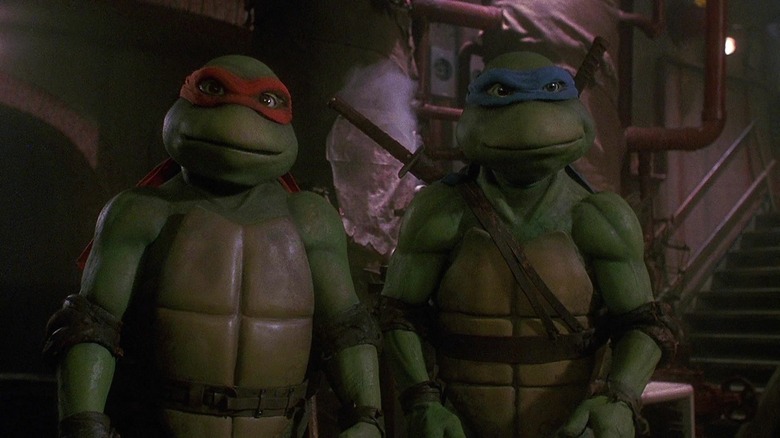The Original TMNT Cast Unknowingly Endured A Sneaky Psychological Test
For those who were between the ages of nine and 12 in 1990, Steve Barron's film "Teenage Mutant Ninja Turtles" was a banner event. It was the first time the ultra-popular mutants were seen in live-action, and Barron did not disappoint. The Turtles were provided by Jim Henson's Creature Shop who constructed full-body foam latex suits for the actors, as well as animatronic, full-head masks. Voice actors would record dialogue, and puppeteers would operate myriad facial servos by remote, making it look like the Turtles were talking. Each of the four title teens required a voice actor, a body actor, a facial puppeteer, and, in a few cases, a fight or skateboarding double. It took 11 actors in total to play four characters.
The result was rather astonishing. The Turtles felt more real than they ever had before or, arguably, since. The facial movements on the mutant masks may have been a little off-putting to some of the adults in the audience, but the 1990 kids were awestruck. It certainly helped that the tone of Barron's film was closer to a crime drama than a fantastical children's adventure. It wasn't violent — it's only rated PG — but it had more grit than the 1987 animated series that many of the audience members were weaned on.
It turns out that making the foam latex/animatronic suits, however, was quite a trial for the actors. Actor Josh Pais played both the voice and the body of Raphael, the angriest of the Turtles, and he recalled the suit-making process being arduous and psychologically taxing. And, as he shared in a 2015 retrospective in the Hollywood Reporter, the makers of the suits actually and deliberately put him and his co-stars through a test to make sure they could handle wearing the suits for extended periods.
Totally encased
The process of making the Turtle suits was massively complicated and was described in a 1990 issue of EW. It was made of 15 separate pieces, and about 40 pounds of wiring were housed in each turtle shell. The wiring led into the mask, operating the facial expressions. The suits were first made of fiberglass, then re-sculpted out of claw before a mold could be made. Actors would be coated in a full-body, full-head casting material that left none of their skin visible. All that was exposed were their nostrils, held open by straws. Waiting for the mold to dry took a long, long time, and actors had to stand stock still, mostly nude and covered in what was essentially plaster, unable to see or talk or hear for the entire time.
Pais recalls that long, long drying process, and the test the people at the Jim Henson Creature Shop pulled. He told the story:
"They flew me to London to Jim Henson's Creature Shop, and I was body-casted from head to toe, every inch of me except for two straws in my nose. It was super intense. They told us afterward that they kept us in that plaster longer than they needed to, just to see if we would freak out."
Seems unkind, but given that shooting days would be long and Pais would need to stay inside the suit for extended periods, it seems the Henson team was not doing it merely to be cruel. Pais did not return for either of the "TMNT" sequels, being replaced by Ken Troum and Laurie Faso for "Teenage Mutant Ninja Turtles II: The Secret of the Ooze" and by Tim Kelleher and Matt Hill for "Teenage Mutant Ninja Turtles III."

